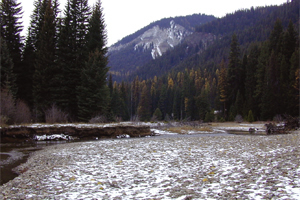Environmental researchers have long been studying the impact of the various physical attributes of moving water sources to better determine their effect on their ecological surroundings. Many of these naturally-occuring phenomena, such as bedforms, could impact everything from a river's flow parameters to its fish habitat.
Kyle Strom, assistant professor of environmental engineering at the UH Cullen College of Engineering, has discovered unique, diamond-shaped patterns of sediment accumulation at the bottom of a river's bed. Known as bedforms, these patterns develop naturally as a moving water source, such as a river or a stream, carry and deposit sediment along its gravel bed.
"We are trying to understand how these bedforms effect the physical characteristics of a river," said Strom, whose findings where recently featured on the cover of Sedimentology. "If we can characterize these phenomena and demonstrate that it has a positive effect on the river habitat, then it might be possible to create man-made structures that emulate bedforms to further promote biodiversity."
According to Strom, bedforms are believed to effect the flow properties of a river. The size, shape and form of these sediment deposits effect how and where water flows and carries particles, which could bring more or less food to a fish habitat, for example, or direct flow away from eroding banks.
"Water flow is one of several contributing factors of erosion," said Strom. "Understanding how these bedforms direct the flow of water may lead to the implementation of engineered structures that reduce the occurance of erosion along river banks, a major step forward in stream restoration."
After conducting field research on two streams located in the Cascade Mountains of Washington State, Strom documented the occurance of various types of bedform clusters, including several instances of rocks forming diamond patterns. Each bedform cluster was mapped and analyzed to not only determine its shape and geometric properties, but also to characterize the spacial arrangement of each cluster along the riverbed.
"What we were able to discover during our field research is that there appears to be a pattern emerging that may help us create models and better predict the movement of sediment in a river," he said."
Strom is currently contructing a large-scale model of a riverbed to begin testing how different bedforms and other naturally-occuring phenomena affect the characteristics of moving water sources and their surrounding environments.
